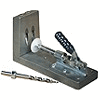 I saw it demonstrated at the various trade and
woodworking
shows, but quite frankly was not impressed, primarily because of the
visible pocket hole. A cabinetmaker friend
however purchased one and said that it and the pocket hole techniques
expounded by Marc Sommerfeld revolutionized
how he made cabinets. A year later, I purchased the Kreg master kit
(Wood Werks Wauconda IL.) and the Sommerfeld basic video. After watching
the video (to learn the Sommerfeld pocket hole technique) I was hooked.
Many, many cabinets later I still
have not found a more efficient "system" for putting together face-frame
cabinets.
I saw it demonstrated at the various trade and
woodworking
shows, but quite frankly was not impressed, primarily because of the
visible pocket hole. A cabinetmaker friend
however purchased one and said that it and the pocket hole techniques
expounded by Marc Sommerfeld revolutionized
how he made cabinets. A year later, I purchased the Kreg master kit
(Wood Werks Wauconda IL.) and the Sommerfeld basic video. After watching
the video (to learn the Sommerfeld pocket hole technique) I was hooked.
Many, many cabinets later I still
have not found a more efficient "system" for putting together face-frame
cabinets.I must underscore the use of the word "system"! I have bought into the "system", lock, stock, and barrel which I believe is essential to make the best use of the tool. And right or wrong, the system works! I challenge anyone to come up with a more efficient system that produces a sturdy, great looking face-frame cabinet. The reason I say right or wrong is that there are many ways to construct a face-frame cabinet. In the past I joined face-frames using mortise and tenons or dowels and attached them to the cabinet sides using biscuits. I attached stretchers and the like also using biscuits. Assembling large cabinets was always difficult when working alone. As we all know, glue works as a great lubricant until it sets. Once the clamps are applied, the workpieces slip and slide half way to .......
The Sommerfeld system pretty much does away with the need to clamp the cabinet parts together during assembly and greatly speeds up the assembly alignment process. As long as you cut everything square, and cut the sides, face frame members, and stretchers to equal length, the cabinet squares up almost automatically when you attach the stretchers and face frames. I typically use one clamp: A 36" one-handed vise-grip quick clamp. Occasionally, I add two Bessy K model clamps if for some reason the cabinet didn't square up right. (Bessy clamps are unique in that they tend to square up whatever they're clamping.)
Because of posts on the various woodworking bulletin boards I must add....The Kreg pocket hole system is designed to hold two GLUED pieces of wood together while the glue sets. I doubt seriously that it is Kreg's intention that one simply uses screws to secure a joint. Several detractors have noted that the angle and depth of the pocket hole created by the Kreg Jig is inferior to other pocket hole tools. If indeed it is inferior, it is only inferior if you are not planning to use glue for the primary bond. The purpose of the Kreg pocket hole and screw is to provide an efficient and convenient means to "clamp" two pieces of wood together. Once the glue cures, the screws are just added reinforcement.
No comments:
Post a Comment